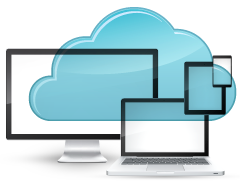How Cloud Computing Can Provide a Secure Remote Platform

Cloud computing is the preferred platform for many organizations of all sizes. It provides a fluid data exchange, flexibility and scalability, and continuous access to data for companies that operate around the clock.
However, cloud computing does introduce new security risks that should be well understood. Cloud computing platforms have several advantages over traditional infrastructure. It allows for rapid and large-scale deployment of computing resources. It also allows companies to save money by only paying for the data resources they need at any given time.
There are several features to look for when identifying a secure remote platform. But taking the time to find one is well worth it since these platforms can help you operate more efficiently without leaving your data, networks, or systems vulnerable.
- Look for a cloud service provider or system with strong data security features. Your cloud system should be designed to use standard security tools, such as antivirus programs, encryption controls, and other features that protect data. A cloud system and its servers must also use the proper security controls that allow the data to move as needed without risk of a data breach.
- Ensure there are backups. The backup setup, systems, and data should also be checked periodically. This backup can be set up directly on your cloud computer. Alternatively, you may use your own server, portable hard drive, or a secondary cloud server. Having backups in place can save your data from many situations where you may be vulnerable, such as suffering a ransomware attack.
- Identify redundant storage solutions. Redundant storage is never a bad thing. You can add internal drives to store and duplicate data. It is much harder to lose your data due to systems failure or cyber crime when you have data redundancy.
- Test your cloud platform occasionally. Testing is vital in identifying security vulnerabilities. You can test your cloud platform to see how it performs related to security. Ethical hackers or IT companies can help you identify any issues within your cloud systems or storage. They may also be able to provide you with recommendations for shoring up security deficiencies.
In addition to these features, you may want to pay attention to a cloud platform to ensure that it includes the following security technologies:
- Encryption: Encryption codes date in a way that ensures only authorized individuals can access and understand the information. If hackers cannot decode the data, it is worthless to them. But more importantly, it protects any sensitive information your company may have related to trade secrets, employees, and customers. Cloud data should be encrypted both at rest or in transit to prevent cyber criminals from intercepting the data and using it.
- Identity and Access Management (IAM): This technology tracks users and defines what they are allowed to do. IAM also authorizes users and rejects those without the proper authorization. This feature is crucial because it determines access rights and privileges, reducing the threat of unauthorized users gaining access to data.
- Firewalls: Cloud firewalls protect cloud data and systems by blocking data threats. Cloud firewalls are hosted on the cloud and form a virtual barrier around cloud infrastructure. For example, cloud firewalls can block DDoS attacks, malicious bot activity, and vulnerability exploits.
In addition to having the right security technology to keep cloud data assets secure, you should also examine your data practices and policies. This would include:
- Developing backup plans and disaster recovery plans. These planning tools can provide a roadmap for when things go wrong (which can happen, whether on the cloud or on-premise). Backup plans can identify additional data resources and redundancies to minimize the impact of a data breach or other disaster.
- Educating users on security best practices. Many – if not most – data breaches occur due to human error. In most instances, the person was unable to identify a threat properly. This could be by falling victim to a phishing attack, installing malware, using devices or apps that have not been updated, or using poor password policies. When you focus on internal education and best practices, you can greatly increase the security of your cloud data assets.
- Look for proper configuration and consistent security policies. Many breaches occur because the company does not have the right security setting configuration or a gap in security measures. You may want to consult with a security expert to ensure you are maximizing the security features and settings.
Cloud computing isn’t going anywhere; it will be a part of many companies’ overall resources. But with the following tips and strategies, you can help ensure your cloud data and assets are secure. To learn more about cloud computing and security, contact Sagacent Technologies today.
